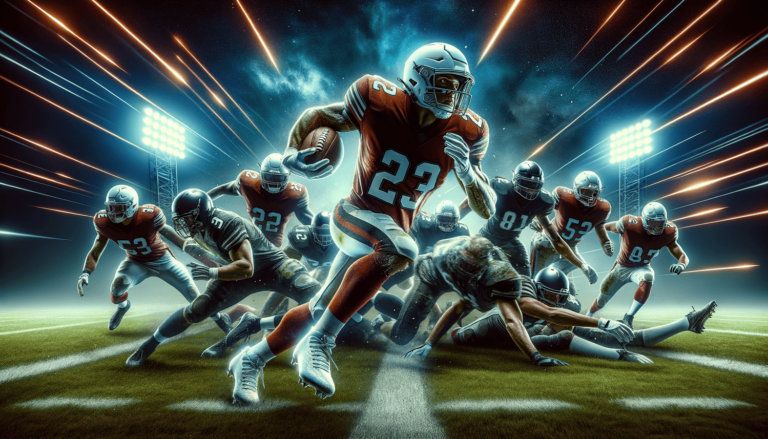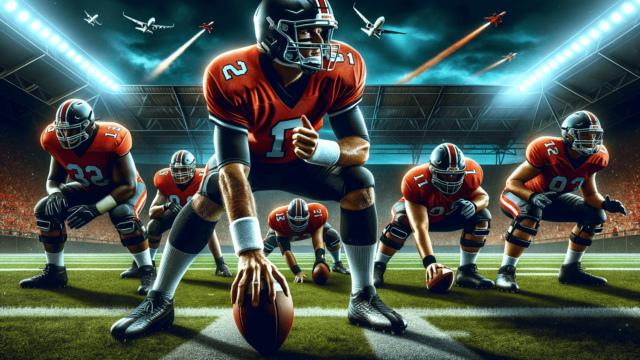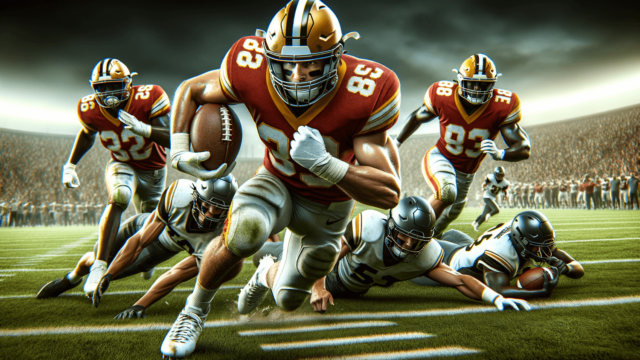
Play action in football is an offensive tactic where the quarterback fakes a handoff to a running back, drawing the defense’s attention, and then throws a pass downfield. This deception creates openings for the receivers, as the defenders commit to stopping the run, allowing for potential big gains through the air.
Understanding Play Action in Football
Play action in football is an offensive tactic designed to deceive the defense by simulating a running play before transitioning to a passing play. The quarterback pretends to hand off the ball to a running back, causing defenders to commit to stopping the run, before stepping back and throwing a pass to an open receiver.
Executing a Successful Play Action
To effectively execute a play action, the offense must perform the following steps:
- Set up the run game: A convincing play action requires the threat of a strong running game. Establishing an effective run game will make the defense respect the potential handoff and bite on the fake.
- Quarterback’s fake handoff: The quarterback needs to sell the fake handoff by extending their arms toward the running back and keeping their eyes on them, creating the illusion of a real handoff.
- Running back’s role: The running back should act as if they have received the ball, sprinting toward the intended gap in the offensive line and engaging tacklers.
- Offensive line’s blocking: The offensive line should initially block as if it is a running play, which further tricks the defense into biting on the fake. They must then quickly transition to pass-blocking to protect the quarterback.
- Receivers getting open: Finally, the receivers should exploit the openings created by the play action, running their routes and separating from defensive backs who have been drawn in by the run fake.
Benefits of Play Action in Football
Play action offers several advantages for the offensive team, including:
- Neutralizing pass rush: By forcing defenders to hesitate and respect the fake handoff, play action can slow down an aggressive pass rush and give the quarterback more time in the pocket.
- Creating open passing lanes: As the linebackers and sometimes even safeties bite on the run fake, receivers can find open space downfield for potentially big gains in the passing game.
- Disguising offensive plays: Play action adds an element of unpredictability to the offense, making it difficult for the defense to anticipate whether a play will be a run or a pass.
Implementing Play Action in Your Offensive Strategy
To effectively incorporate play action into your game plan, consider the following tips:
- Analyze the opponent’s defense: Identify any defensive tendencies or weaknesses that can be exploited using play action, such as aggressive linebackers keen to stop the run.
- Vary play action calls: Keep the defense guessing by calling play action at unexpected moments and varying the types of plays you run off the fake handoff.
- Practice deception: Ensure all offensive players are well-versed in selling the fake handoff through practice and repetition, as the success of play action hinges on the convincing nature of the deception.
Keys to Defending Against Play Action
While play action can generate considerable advantages for the offense, defenses can counter this tactic by following some key principles:
- Assignment discipline: Defenders must remain disciplined in their assignments and responsibilities, focusing on reading their keys before reacting to a perceived handoff.
- Eye discipline: Defenders, especially linebackers and safeties, need to maintain eye discipline by watching the quarterback’s and running back’s movements. Getting caught watching the backfield can lead to blown coverages and big gains for the offense.
- Pass rush integrity: Defensive linemen should maintain their rush lanes and avoid over-pursuit. Overcommitting to the run fake can leave the quarterback with a clean pocket and wide-open passing lanes.
- Communication: Proper communication among defensive teammates is crucial for recognizing play action and making the necessary adjustments in coverage.
Examples of Play Action Variations
Play action in football comes in several variations, each offering distinct advantages. Some popular examples include:
- Bootleg: The quarterback fakes a handoff and rolls out of the pocket to the opposite side, allowing them to escape pressure and find open receivers on the run.
- Naked bootleg: Similar to a regular bootleg, but without any pulling blockers to protect the quarterback. This relies on the element of surprise and the defense overcommitting to the run.
- Reverse play action: The quarterback fakes a reverse or an end-around, drawing the defense’s attention, and then throws a pass downfield to a receiver left open by the misdirection.
- Screen play action: Combines a fake handoff with a screen pass, slipping the receiver or running back out into the flat while the defense bites on the play action.
Notable Play Action Quarterbacks in NFL History
Many quarterbacks have found success utilizing play action throughout their careers. Some NFL legends particularly proficient at executing play action include:
- Peyton Manning: Manning was a master of pre-snap adjustments and play action, using meticulous play fakes to consistently generate big plays through the air.
- Joe Montana: Montana’s quick release, accurate throws, and superb play action fakes made him one of the most successful play action quarterbacks in NFL history.
- Tom Brady: Known for his precision and decision-making, Brady has carved a legendary career that includes effectively utilizing play action to keep defenses off-balance.
- Russell Wilson: Wilson’s mobility and play extension ability, combined with his convincing play action fakes, create big-play opportunities both with his arm and his legs.
Frequently Asked Questions About Play Action
After reading about play action in football, you might have some questions on the topic. Here are some of the most common questions and their answers to help you better understand this offensive tactic.
How does the effectiveness of play action change based on the level of football?
Play action can be effective at all levels of football, from youth leagues to professional games. The success of play action largely depends on the proper execution of fakes, the quality of the run game, and the ability of the quarterback to read the defense. As players’ skills improve at higher levels, defenses tend to be more disciplined, making play action execution even more critical to its effectiveness.
Is play action more difficult for a young or inexperienced quarterback to execute?
Play action can be difficult for an inexperienced quarterback since it requires proper footwork, effective fakes, and swift decision-making. However, practice and repetition can help even the youngest quarterbacks improve their play action abilities, and with the right coaching, it can become a valuable weapon in their arsenal.
How important is a strong running game for the success of play action?
A strong running game plays a crucial role in the success of play action. If the defense does not view the offense’s run game as a threat, they are less likely to bite on the play action fake, reducing its effectiveness. A consistent run game forces the defense to respect the potential handoff, making play action more successful and creating larger opportunities for passing downfield.
What are some ways to diagnose and defend play action as a defender?
Defenders can diagnose and defend play action by maintaining assignment and eye discipline, focusing on their keys instead of being drawn in by the run fake. Communication among defensive teammates is also crucial for recognizing play action and making necessary adjustments in coverage. Pass rush integrity helps prevent open passing lanes, while remaining disciplined ensures that the defender is in the best position possible to defend both the run and the pass.
Are certain offensive formations more conducive to play action success?
Yes, certain formations can enhance play action success. Formations that commonly feature a strong run game, such as I-Formation, Singleback, or Pro Set, can be more effective for play action as they convincingly sell the run threat. Additionally, formations that create initial confusion or disguise based on pre-snap movement and personnel groupings can further increase the effectiveness of play action by keeping defenses guessing.
Featured Posts
- No pillar pages found.





